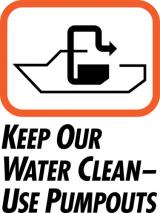Vessel Sewage No-Discharge Zones
You may need a PDF reader to view some of the files on this page. See EPA’s About PDF page to learn more.The Clean Water Act (CWA) is the centerpiece of federal legislation addressing pollution in U.S. waters. Under section 312 of the CWA, vessel sewage may be controlled through the establishment of areas in which discharges of sewage from vessels are not allowed. These areas are also known as "no-discharge zones" (NDZs).
What is an NDZ for vessel sewage?
An NDZ is an area in which both treated and untreated sewage discharges from vessels are prohibited. Within NDZ boundaries, vessel operators are required to retain their sewage discharges onboard for discharge at sea (beyond three miles from shore) or onshore at a pump-out facility.
How is an area designated as an NDZ under the CWA?
The CWA lists three circumstances where a state may initiate the process to establish an NDZ:
- The state determines that the water body requires greater environmental protection, and EPA finds that adequate pump-out facilities are available. (Commonly known as a 312(f)(3) NDZ) A state may completely prohibit sewage discharge from vessels, whether the sewage is treated or not, into some or all of its waters if:
- the state determines that the protection and enhancement of the quality of the waterbody requires greater environmental protection than the current federal standards allow; and
- EPA determines that adequate facilities for the safe and sanitary removal and treatment of sewage from vessels are reasonably available. (33 U.S.C. 1322(f)(3) (PDF)(10 pp, 170 K)).
- The EPA, upon application by the state, determines that the protection and enhancement of the water body requires establishment of an NDZ. (Commonly known as a 312(f)(4)(A) NDZ) If the EPA determines, upon application by a state, the protection and enhancement of specified waters requires sewage discharges to be prohibited, the EPA will prohibit, by regulation, sewage discharge from a vessel. This prohibition will occur whether the sewage is treated or not into those waters. Unlike NDZs established pursuant to CWA section 312(f)(3) (described above), the state does not have to show adequate pump-out facilities are reasonably available to request this type of NDZ be established (33 U.S.C.1322(f)(4)(A) (PDF)(10 pp, 170 K)).
- Drinking water intake zones. (Commonly known as a 312(f)(4)(B) NDZ) The EPA, upon application by a state, will prohibit, by regulation, sewage discharge from vessels within a drinking water intake zone. The purpose of this NDZ is to safeguard human health through the protection of intake waters used for drinking. The state does not need to show that adequate pump-out facilities are reasonably available to establish this type of NDZ. (33 U.S.C.1322(f)(4)(B) (PDF)(10 pp, 170 K)).
Who enforces the NDZ requirements?
Under section 312 of the CWA, the U.S. Coast Guard and the state in which the NDZ has been designated may enforce the NDZ requirements. (33 U.S.C. 1322(k) (PDF)(10 pp, 170 K)).
How does a vessel operator comply with an NDZ?
The requirements for vessel operators are described in 33 CFR 159.7(b)-(c) (PDF) (2 pp, 190 K). The regulations allow for four methods of securing a Type I or II marine sanitation device (MSD) while in an NDZ, including:
- Closing the seacock and removing the handle;
- Padlocking the seacock in the closed position;
- Using a non-releasable wire-tie to hold the seacock in the closed position; or
- Locking the door to the space enclosing the toilets with a padlock or door handle key lock.
For Type III devices, the following options are available:
- Closing valves leading to overboard discharge and removing the handle;
- Padlocking any valves leading to overboard discharge in the closed position; or
- Holding overboard discharge valves closed using a non-releasable wire-tie.
Which states have NDZs?
A number of states have designated some or all of their surface waters as NDZs. A list of established NDZs may be found at No-Discharge Zones by State. Visit the No-Discharge Zones Map webpage to view an interactive GIS map of all designated NDZs, as well.

